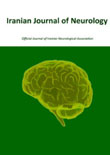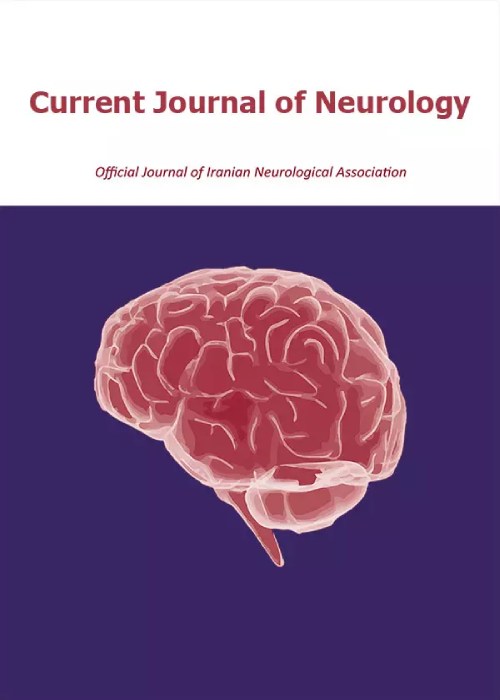فهرست مطالب

Current Journal of Neurology
Volume:15 Issue: 3, Summer 2016
- تاریخ انتشار: 1395/05/23
- تعداد عناوین: 13
-
-
Pages 111-120BackgroundMultiple sclerosis (MS) is a neurological disease with a variety of signs and symptoms. Exercise therapy has been shown to improve physical functions in MS. However, questions about an optimal exercise therapy remain. In this regard, we suggest a combined exercise therapy including aerobic and resistance exercises for MS patients. The study is designed to observe, test and compare the effects of proposed combined exercises on strength, balance, agility, fatigue, speed, and walking distance in people with mild to moderate MS [0MethodsA total of 40 people with relapse-remitting MS (16 male, 0ResultsFor most tests, post-intervention values of the group 1, with 3-aerobic and 1-resistance exercises, were significantly higher compared to control group (PConclusionA combination of three aerobic exercises with one resistance exercise may result in improved balance, locomotion, and endurance in MS patients.Keywords: Multiple Sclerosis, Exercise Therapy, Aerobic Exercise, ýResistance Training
-
The correlation between dietary fat intake and blood pressure among people with spinal cord injuryPages 121-127BackgroundStudies have demonstrated the effect of different dietary fats on blood pressure (BP) in general population. However, these associations have not yet been described in people with spinal cord injury (SCI).MethodsReferred patients to Brain and SCI Research Center between 2011 and 2014 have been invited to participate. Only paraplegic individuals were recruited and patients with injury at cervical or higher thoracic sections were excluded to omit the bias effect of autonomic dysreflexia. Dietary intakes were assessed by recording consumed foods by 24-hour dietary recall interviews using Nutritionist IV 3.5.3 modified for Iranian foods. Systolic BP (SBP) and diastolic BP (DBP) were measured 3 times and the mean values entered analysis.ResultsHigher intakes of cholesterol were related to higher BP (P = 0.010 and 0.011 for SBP and DBP, respectively). Similarly, intake of saturated fat was positively correlated to both SBP (P = 0.016, r = 0.21) and DBP (P = 0.011, r = 0.22). The effect of eicosapentaenoic acid (EPA) on BP was insignificant (P = 0.760 and 0.720 for SBP and DBP, respectively). However, intake of docosahexaenoic acid (DHA) was related to lower BP among people with SCI.ConclusionThis study has demonstrated that higher intakes of cholesterol and saturated fat are associated with increased BP, whereas DHA is an antihypertensive agent. Dietary modifications with reduction of cholesterol and saturated fat along with intake of additional DHA supplements may help to reduce BP in spinal cord injured-individuals with hypertension.Keywords: Hypertension, Spinal Cord Injury, Dietary Fats, Blood ýPressure
-
Pages 128-132BackgroundDysphagia as a common condition affecting many aspects of the patients life. The Dysphagia Handicap Index (DHI) is a reliable self-reported questionnaire developed specifically to measure the impact of dysphagia on the patients quality of life. The aim of this study was to translate the questionnaire to Persian and to measure its validity and reliability in patients with neurogenic oropharyngeal dysphagia.MethodsA formal forward-backward translation of DHI was performed based on the guidelines for the cross-cultural adaptation of self-report measures. A total of 57 patients with neurogenic dysphagia who were referred to the neurology clinics of Tehran University of Medical Sciences, Iran, participated in this study. Internal consistency reliability of the DHI was examined using Cronbachs alpha, and test-retest reliability of the scale was evaluated using intraclass correlation coefficient (ICC).ResultsThe internal consistency of the Persian DHI (P-DHI) was considered to be good; Cronbachs alpha coefficient for the total P-DHI was 0.88. The test-retest reliability for the total and three subscales of the P-DHI ranged from 0.95 to 0.98 using ICC.ConclusionThe P-DHI demonstrated a good reliability, and it can be a valid instrument for evaluating the dysphagia effects on quality of life among Persian language population.Keywords: Dysphagia, Disability Evaluations, Persian, Iran, ýReliability, Validity, Neurologic Disorders, ýReproducibility of Results, Questionnaire Design
-
Pages 133-139BackgroundThe aim of this study is to determine the frequency of intracranial artery stenosis in patients with acute ischemic stroke in Iran.MethodsA total of 169 patients with acute ischemic stroke were eligible to participate and were enrolled in this study from January 2012 to February 2013. All the patients were admitted to the Nemazee ýHospital, affiliated to Shiraz University of Medical Sciences, Iran. They underwent transcranial Doppler (TCD) ultrasonography. Mean flow velocity (MFV) of basilar artery, vertebral artery, middle cerebral artery (MCA), anterior cerebral artery (ACA), and posterior cerebral artery (PCA) were evaluated.ResultsA mean of patients age was 67.80 ± 8.14 years. There were 83 men (49.1%) and 86 women (50.9%). Overall, 43 patients (25.4%), with a mean age of 66.7 ± 6.2 years, had intracranial stenosis. The number of men and women with intracranial stenosis was comparable (52.4% men vs. 47.6% women). Hypertension (PConclusionThe prevalence of intracranial artery stenosis in patients with acute ischemic stroke is 25.4% which is comparable with previous reports from Iran and other Middle East countries.Keywords: Ischemic Stroke, Intracranial Arteries, Transcranial ýDoppler Ultrasonography, Atherosclerosis
-
Pages 140-145BackgroundPost-stroke dysphagia is common and is associated with the development of pneumonia. To investigate the effects of repetitive transcranial magnetic stimulation (rTMS) combined with traditional dysphagia therapy (TDT) on swallowing function in patients with post-stroke dysphagia.MethodsIn this single-subject study, four patients with dysphagia post-stroke included. The patients received the rTMS applied to the intact cerebral hemisphere at 1 Hz with train of 1200 for 5 consecutive days combined with TDT 3 days per week for 6 weeks. The main outcome measure was the Mann Assessment of Swallowing Ability (MASA). Measurements were taken before, after the end of 5th, 10th, 15th treatment sessions, and after the end of the treatment (18th session).ResultsThe MASA scores improved in all patients following treatment. The maximum and minimum change in level between the baseline phase and treatment phase was and . The greatest percentage improvement was observed after 5th treatment sessions ranging between 11 and 35%. The treatment trend was upward shown by the directions of the slopes indicated by positive values (.1-.7). The dysphagia was resolved after 10th treatment session in all participants. The aspiration resolved in two participants after the 5th treatment session and resolved in another 2 participants after the 10th treatment session.ConclusionThe combination therapy of rTMS plus TDT improved swallowing function in patients with post-stroke dysphagia. Further research with a larger sample size is recommended.Keywords: Stroke, Dysphagia, Rehabilitation, Combined Modality ýTherapy, Transcranial Magnetic Stimulation, Deglutition ýDisorders
-
Pages 146-152BackgroundStroke is one of the most frequent causes of death and disability worldwide and has significant clinical and socioeconomic impact. Hyperlipidemia and inflammation play major roles in atherothrombosis and in stroke. This study is conducted to compare the high sensitive C-reactive protein (hs-CRP) levels and the lipid profile parameters between stroke patients and control group and demonstrate correlation between markers, neurological deficit, and short-term outcome.MethodsWe have studied a total 162 patients according to inclusion criteria. Serum level of hs-CRP and lipid profile estimated and correlated with neurological deficit and short-term outcome.ResultsWe found stroke patients had significantly higher levels of hs-CRP, total cholesterol (TC), triglyceride (TG), low-density lipoprotein (LDL), and low level of high-density lipoprotein (HDL) than control. When we compared ischemic and hemorrhagic stroke (HS), data show increased level of triglyceride, LDL and HDL, and decreased the level of hs-CRP in ischemic stroke group than HS group. However, the National Institutes of Health Stroke Scale (NIHSS) score significantly higher in HS as compared to ischemic stroke at the time of admission and on the 7th day.ConclusionThus, continuous clinical observation is necessary for clear differentiation of those changes. Furthermore, the determination of some reliable soluble markers of neuronal damage in blood and cerebrospinal fluid in the early infarction period would be much easier and more useful for tracking the course and prognosis of the disease and for any appropriate therapeutic approach.Keywords: Stroke, Lipid Profile, Ischemic Stroke
-
Pages 153-163BackgroundMesial temporal lobe epilepsy (TLE) is a remediable epileptic syndrome. About 40% of patients continue to have seizures after standard temporal lobectomy. It has been suggested that some of these patients could actually suffer from a more complex epileptogenic network. Because a few papers have been dedicated to this topic, we decided to write an article updating this theme.MethodsWe performed a literature search using the following terminology: temporal plus epilepsy and networks, temporal plus epilepsy, orbito-temporal epilepsy, temporo-insular epilepsy, temporo-parieto-occipital (TPO) epilepsy, parieto-temporal epilepsy, intracortical evoked potential and temporal plus epilepsy, temporal lobe connectivity and epilepsy, intracortical evoked potential and epilepsy surgery, role of extratemporal structures in TLE, surgical failure after temporal lobectomy, Diffusion tensor imaging (DTI) and temporal epilepsy, and positron emission tomography (PET) in temporal plus lobe epilepsy in the existing PubMed databases. We searched only English and Spanish literature. Only papers that fit with the above-mentioned descriptors were included as part of the evidence. Other articles were used to reference some aspects of the temporal plus epilepsy.ResultsA total of 48 papers from 2334 were revised. The most frequently reported auras in these groups of patients are gustatory hallucinations, vestibular illusions, laryngeal and throat constriction, atypical distribution of somatosensory symptoms (perioral and hands, bilaterally hands paresthesias, trunk and other). The most common signs are tonic posturing, hemifacial twist, and frequent bilateral clonic movements. Interictal electroencephalographic (EEG) patterns exhibit regional and frequently bilateral spikes and/or slow waves. The first ictal electrographic change is mostly regional. It is important to note that the evidence is supported by case series or case reports. Thus, most of the data presented could represent the features on these cases and not actually the totality of the iceberg.ConclusionTemporal plus epilepsy is a diagnosis that can be done only after the invasive recordings have been analyzed but an adequate suspicion may arise based on clinical, EEG and imaging data.Keywords: Temporal Lobe Epilepsy, Insular Cortex, Drug Resistant, ýNeural Networks, Intracranial Electroencephalography, ýPositron Emission Tomography
-
Pages 164-172BackgroundAlzheimers disease (AD) is the most common type of dementia. Demonstrating the modifiable risk factors of AD can help to plan for prevention of this disease. The aim of the current review was to characterize modifiable cardiovascular risk factors of AD using existing data and determine their contribution in AD development in Iran and the world.MethodsThe systematic search was done in Medline, Scopus, and Cochrane databases from inception to May 2014 to find systematic reviews or meta-analyses about association between AD and cardiovascular modifiable risk factors included diabetes, hypertension (HTN), physical inactivity, smoking, hypercholesterolemia, and overweight and obesity. The population attributable fraction (PAF) was calculated for these risk factors in Iran and the world.ResultsOf 2651 articles, 11 were eligible for data extraction after assessing relevancy and quality. Diabetes mellitus (DM) type 2, smoking, physical inactivity, overweight and obesity were significantly associated with increased risk of AD. Physical inactivity with 22.0% and smoking with 15.7% had the highest PAF for AD in Iran and the world, respectively.ConclusionOur findings demonstrated that modifiable cardiovascular risk factors could increase the risk of AD. Moreover, about one-third of AD cases were attributed to five modifiable risk factors.Keywords: Alzheimer Disease, Risk Factors, PAF


